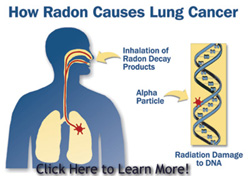United States EPA
Is radon really bad for you?
Breathing radon over time increases your risk of lung cancer. Radon is the second leading cause of lung cancer in the United States. Nationally, the EPA estimates that about 21,000 people die each year from radon-related lung cancer. Only smoking causes more lung cancer deaths.
Youngsters that are house all day long go to a lot more threat for breathing. Figure out why radon threatens and why it's so hard to find without screening. The research sounds the fatality knell of the linear, no limit concept, while unlocking to the theory of hormesis-- the idea that low levels of ionizing radiation might actually benefit you.
Scientist concentrated on 2,500 Finns who had resided in the very same homes-- having low to high interior radon levels-- for twenty years; they took care to change for cigarette smoking. " Our results do not suggest enhanced threat of lung cancer from indoor radon." The study implies that indoor radon exposure does not appear to be an important root cause of lung cancer. Radon is a contaminated gas given off naturally from the ground.
Is radon mitigation really necessary?

When radon gas enters the body, it exposes the lungs to small amounts of radiation. In small quantities, experts say this is harmless. However, in persistent exposures or larger quantities, radon can damage the cells of the lining of the lungs, increasing a person's chance of developing lung cancer.
We stroll outdoors and also operate in the sunlight, revealing ourselves to ultraviolet radiation as well as increasing our threat of creating skin cancer cells. We drive in vehicles practically on a daily basis despite the fact that greater than 1 in 86 fatalities is a result of car accidents. Individuals smoke, consume inadequately, and also take part in unsafe habits every day. To some degree, radon gas is an additional daily danger that most of us should take.
- Your danger of lung cancer cells enhances substantially with direct exposure to greater radon levels.
- Radon gas is a naturally-occurring result of the radioactive decay of Uranium in the soil.
- Depending upon your geographical place, the radon degrees of the air you breathe outside of your home may be as high as 0.75 pCi/L.
- The nationwide standard of outdoors radon degrees is 0.4 pCi/L as well as it is estimated by the National Academy of Sciences that outdoor radon levels create approximately 800 of the 21,000 radon induced lung cancer fatalities in the US each year.
- The US EPA has actually put it plainly, specifying, "Any kind of radon exposure has some threat of creating lung cancer.
How do you eliminate radon?
Possible symptoms include shortness of breath (difficulty breathing), a new or worsening cough, pain or tightness in the chest, hoarseness, or trouble swallowing. If you smoke and you know you've been exposed to high levels of radon, it's very important to quit smoking.
If they are revealed to radon, people that smoke or made use of to smoke have an also higher possibility of establishing lung cancer cells. You might just consider what you're subjected to outdoors when you assume regarding pollution. Yet indoor air quality in your home issues, also, Find more information and it can be majorly impacted by the visibility of a contaminated gas called radon. This gas can accumulate to dangerous levels as well as enhance your risk for establishing lung cancer-- even if you do not smoke, according to the American Lung Association.

Health
The study paid close attention to the mate's levels of cigarette smoking, job-related exposure to health hazards and education attainment. Nevertheless, unlike the majority of the residential radon researches, the study was not population-based.
How long does it take for radon to cause cancer?
Fact: You will reduce your risk of lung cancer when you reduce radon levels, even if you've lived with an elevated radon level for a long time. Keep in mind that radon levels below 4 pCi/L still pose some risk and that radon levels can be reduced to 2 pCi/L http://public.sitejot.com/fsbfcbj477.html or below in most homes.